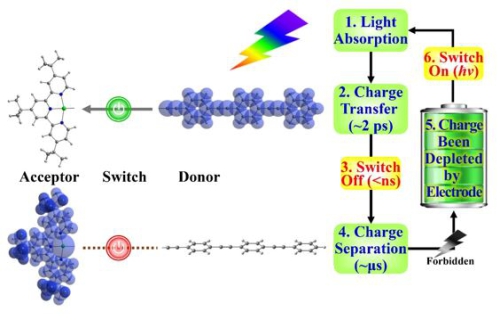Recently, Professor Jiang Jun, a research team led by Luo Yi, a professor at the China National Science and Technology University's National Institute for Microscale Physics Research, used first-principles calculations to propose the first adaptive switch organic molecular solar cell design. This solution has the advantages of low cost, high efficiency, and adaptability. Solar cells are very promising. Although solar cells based on organic molecules have many advantages such as wide material sources, low cost, simple process, good flexibility, ease of mass production, lightness, softness, portability, degradability, and low environmental pollution, their photoelectric conversion efficiency is not high. Compared with inorganic semiconductor solar cells, there is still a large gap. This is because after light energy is absorbed by organic molecules, although charge transfer from the donor part to the acceptor occurs, the carrier mobility of organic molecules is low, and the energetic excited electrons are often bound to the same small In the molecule, electrons and holes that are not completely separated are easily recombined, which greatly reduces the final photoelectric conversion efficiency. Jiang Jun's research group has long devoted himself to the research of optoelectronic functional molecules and photocatalytic systems in the field of design and simulation. He focused on the key thread of electron motion and conducted structural design based on first-principles simulations to regulate the evolutionary behavior of electrons after being excited by light. In this study, the photoswitching molecule azobenzene was inserted into a typical donor-acceptor system (tripyridine-platinum complex) to form a donor-optic switch-receptor system. First-principles calculations show that the molecule has a planar conjugated configuration that absorbs visible light and that the resulting stimulated electrons rapidly transfer from the azobenzene and donor to a lower-energy acceptor (about 2 times longer) Second, the cis-trans isomer barrier of the azobenzene molecule that loses electrons will decrease, resulting in a spontaneous trans-cis configuration (time scale: picoseconds - nanoseconds); molecular configuration shifts. As a result, the conjugated structure of the system is destroyed and the electrical conductivity is greatly reduced. The energetic excited electrons on the acceptor cannot return to the azobenzene and the donor, so that the electron and the hole are stored on the acceptor and the donor, respectively. Efficient charge separation is achieved (excited-state lifetime is on the order of microseconds); when stimulated electrons are consumed (flow into the electrode), the molecules return to the ground state, at which point the azobenzene is still in the cis configuration due to azo Due to the benzene's own characteristics, the cis-molecules can absorb visible light and switch back to the trans-configuration and begin the next cycle. The system suppresses the charge recombination process in organic solar cells, realizes efficient charge separation and automatic switching of molecular conductivity, and is the first adaptive switch organic solar cell design. In addition, the donor-optic switch-receptor system is not limited to azobenzene and terpyridine complex molecules. Other photoswitching molecules and donor-acceptor systems can also be used in this complex system. This design adopts organic small molecules as materials, solves the problem that the charge recombination and conductivity cannot be switched easily in organic solar cells, and provides a large-scale, low-cost, easy-to-synthesize organic molecular system for solar cells and photocatalysis applications. Research ideas. Relevant research results were published in the "Physical Chemistry Express", doctoral students Wu Ziye, Dr. Cui Peng and Zhang Guofan were the co-first authors, and Jiang Jun was the author of the correspondence. The study was funded by a special project for young scientists from the National Key Basic Research and Development Program, the National Natural Science Foundation, and the Strategic Pilot Science and Technology Project of the Chinese Academy of Sciences. Undermount Hand Made Sink, because the beautiful sex that hides in the water is a few stronger, the stainless steel thickness that handwork cistern place USES at the same time is met relatively thicker a few, this guaranteed the case that cistern does not appear easily leak.At the same time compare with traditional cistern,Undermount Hand Made Sink is stronger, more easy clean, more beautiful, and do the work more fine, not easy bad. Undermount Kitchen Sink,Stainless Steel Handmade Sink,Handmade Stainless Steel Sink,Best Undermount Kitchen Sinks SUNRISE HOME GOODS(M)SDN.BHD. , https://www.sunrisesink.com